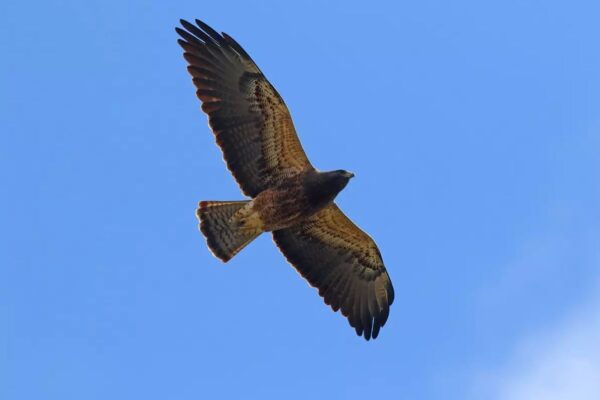A males and two female Buffleheads. Photo by Mick Thompson, downloaded from audubon.netx.net
Bufflehead
Bucephala albeola
By Rajiv Jauhari
Among the duck species that spend winters in Central Texas, one of my favorites is North America’s smallest diving duck, the Bufflehead. If the sun is shining just right, Buffleheads (especially the males) can be identified from a distance even without binoculars. The males have a large white patch on a dark head, with white chest and flanks and a dark back. Their heads can look disproportionately large, which also helps in identification. The contrast between the white and dark parts of their bodies is so vivid that to me they sometimes appear to be generating their own light, like little black-and-white lamps floating on the water. From a distance the dark parts of the heads can appear black, but they are actually glossy green and purple. Females are smaller and less striking, with mostly dark brown heads and backs, but can usually be identified by the single horizontal white patch behind the eyes.
The name Bufflehead comes from the archaic word “buffle,” meaning buffalo. Apparently the relatively large heads of the males appeared to resemble buffalo heads to some. They have also been called “spirit duck,” “butterball” and (in Japanese) “princess white wing.”
Buffleheads breed mostly in boreal forests and aspen parkland of Canada and Alaska. They are secondary cavity nesters, occupying holes excavated by other birds such as Northern Flickers. Buffleheads will also use nest boxes if available. Their small size may have evolved with the habit of nesting in tiny cavities. In non-breeding season, they have been seen as far away as Japan, Central Europe, and Portugal. Buffleheads breeding west of the Rockies tend to migrate to the West Coast, while those breeding in Central Canada tend to migrate to the east or south, including Texas. They migrate at night like many other ducks; overnight migratory flights of several hundred miles are probable. Ground speed during migration is estimated at 40 miles an hour.
Buffleheads are monogamous, and retain the same mate for several years. Females often re-use the same nest site year after year. The oldest Bufflehead on record was a male over 18 years old. Less sociable than many ducks, they tend to be seen in small flocks. Both males and females disappear for a few seconds as they dive for food (insects, crustaceans, and mollusks), and re-merge some distance away.
The next time you are near a duck-frequented watery spot, keep your eyes open for these cute little ducks visiting from Canada. In Travis County, the Longhorn Dam area can have numerous Buffleheads, and Hornsby Bend often has some.
Sources:
www.audubon.org
https://www.10000birds.com/what-makes-you-stare-so-bufflehead.htm
birdsoftheworld.org




